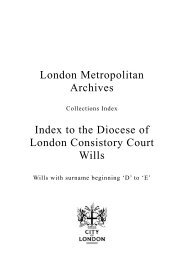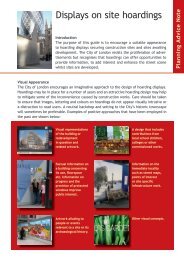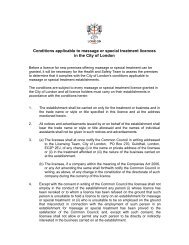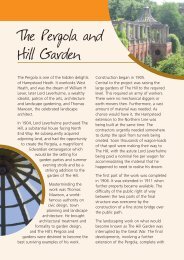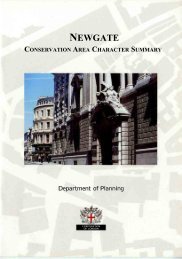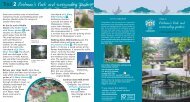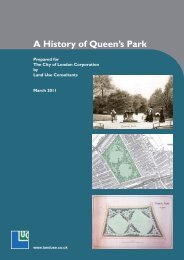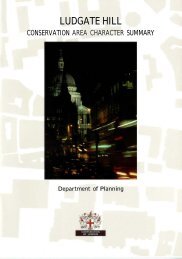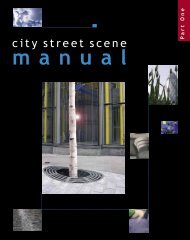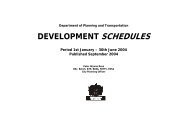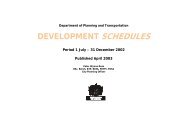Burnham Beeches Management Plan 2010 - the City of London ...
Burnham Beeches Management Plan 2010 - the City of London ...
Burnham Beeches Management Plan 2010 - the City of London ...
You also want an ePaper? Increase the reach of your titles
YUMPU automatically turns print PDFs into web optimized ePapers that Google loves.
2 <strong>the</strong> need for <strong>Management</strong> - climate change and pollution<br />
2.3 The implications <strong>of</strong> climate change<br />
The <strong>Burnham</strong> <strong>Beeches</strong> we see today is <strong>the</strong><br />
consequence <strong>of</strong> centuries <strong>of</strong> active management<br />
in a relatively stable environment, but <strong>the</strong> future<br />
climate is uncertain.<br />
Current predictions What Do You Like Most?<br />
suggest that tree species “The quiet woods<br />
such as beech and oak and wildlife and<br />
may decline in health<br />
vibrant colours”<br />
2009 public consultation<br />
whilst o<strong>the</strong>rs, present<br />
today in lower numbers, such as rowan and<br />
whitebeam may fare better. The consequence<br />
for this may be a more scrubby and open<br />
woodland with lower tree canopies.<br />
Heathland communities, today dominated by<br />
ericaceous species like hea<strong>the</strong>r, are also<br />
predicted to change to a more grass dominated<br />
community.<br />
Trying to ensure <strong>Burnham</strong> <strong>Beeches</strong> is robust in<br />
<strong>the</strong> face <strong>of</strong> <strong>the</strong>se changes will be a challenge,<br />
especially when it is difficult to be certain about<br />
<strong>the</strong> future climate. Increasing structural<br />
diversity (achieved through grazing) creating<br />
pollards from a wider range <strong>of</strong> species,<br />
monitoring changes in tree health and<br />
vegetation, working to reduce <strong>the</strong> fragmentation<br />
<strong>of</strong> habitats locally and carrying<br />
out specific research projects<br />
are all aspects that need<br />
to be considered in<br />
order to help this process.<br />
2.4 Reducing fragmentation and<br />
pollution<br />
Increased development in <strong>the</strong> area around<br />
<strong>Burnham</strong> <strong>Beeches</strong> has had a huge impact in<br />
recent years. Two hundred years ago <strong>the</strong><br />
<strong>Beeches</strong> was a wooded and heathy common,<br />
within <strong>the</strong> genuinely rural landscape <strong>of</strong> south<br />
Bucks; now it is a green island within a largely<br />
urban environment.<br />
Modern life has a clear<br />
impact on <strong>the</strong> <strong>Beeches</strong><br />
as <strong>the</strong> population <strong>of</strong> <strong>the</strong><br />
surrounding area has<br />
risen and increased car<br />
What Do You Like Most?<br />
“Lack <strong>of</strong> traffic; <strong>the</strong><br />
scenery, relative<br />
peace and quiet”<br />
2009 public consultation<br />
use helps people from near and far to access<br />
<strong>the</strong> area more easily. Increased housing density<br />
puts pressure on <strong>the</strong> availability <strong>of</strong> water from<br />
<strong>the</strong> ground and increases <strong>the</strong> air, light, noise<br />
and water pollution. An increase in <strong>the</strong> number<br />
and size <strong>of</strong> cars causes yet more pollution, from<br />
exhausts and tyres, as well as physically eroding<br />
<strong>the</strong> road sides.<br />
The consequence is a reduction in <strong>the</strong> space available<br />
for wildlife and <strong>the</strong> fragmentation <strong>of</strong> those<br />
remaining areas. These small fragments are <strong>the</strong>n<br />
subject to greater pollution and general erosion<br />
due to <strong>the</strong> high concentration <strong>of</strong> people living<br />
nearby. Linking small areas and especially linking<br />
biodiversity hot spots such as <strong>Burnham</strong> <strong>Beeches</strong><br />
and o<strong>the</strong>r local SSSIs is <strong>of</strong> high importance to<br />
maintain viable populations <strong>of</strong> species and<br />
enabling <strong>the</strong>m to spread throughout <strong>the</strong> region.<br />
20<br />
It is vital that <strong>the</strong> <strong>City</strong> <strong>of</strong> <strong>London</strong> works with<br />
neighbouring land owners to try to reverse this<br />
fragmentation and provide additional recreation<br />
areas where possible. This is <strong>of</strong> increasing<br />
importance and urgency in a world facing<br />
uncertain climates in <strong>the</strong> future.<br />
Trees and o<strong>the</strong>r plants and animals at <strong>Burnham</strong><br />
<strong>Beeches</strong> are under increasing stress from<br />
pollution, changes in ground water, climatic<br />
changes and <strong>the</strong> direct impacts <strong>of</strong> people; this<br />
can already be seen. The old trees are<br />
particularly vulnerable to stress and an<br />
important part <strong>of</strong> <strong>the</strong> future planning <strong>of</strong> <strong>the</strong><br />
<strong>Beeches</strong> will be to reduce <strong>the</strong>se stresses.<br />
20



